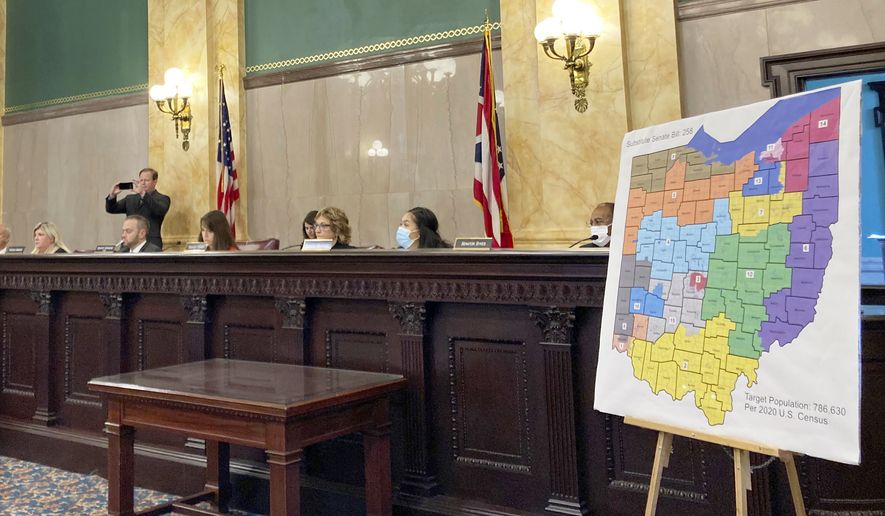COLUMBUS, Ohio (AP) — The next set of proposed boundaries for new state legislative districts has arrived at the Ohio Supreme Court, which must decide for the fourth time whether the maps are constitutionally sound.
The likelihood of the court approving those maps already appeared uncertain, after the state’s political mapmaking body created them late Monday from a previously rejected set of maps.
In a related development, new and still-disputed congressional maps are likely to stay in place for the May 3 primary, under a schedule for hearing arguments in that case established by the state Supreme Court on Tuesday morning. Arguments and counterarguments were scheduled well past the primary.
The GOP-controlled Ohio Redistricting Commission approved those congressional maps March 2 over Democrats’ objections that they unfairly favor Republicans.
Late Monday, the redistricting commission voted 4-3 along mostly partisan lines to revive a set of slightly altered legislative maps already rejected by the Supreme Court earlier this month. In doing so, the commission set aside the efforts of two independent mapmakers paid $450 an hour for the last four days to draw new maps in work viewed step-by-step online.
Four Republicans - Secretary of State Frank LaRose, Senate President Matt Huffman, House Speaker Bob Cupp, and Gov. Mike DeWine - voted in favor of the tweaked maps.
Republican State Auditor Keith Faber joined state Sen. Vernon Sykes, an Akron Democrat, and Rep. Allison Russo, the top House Democrat, in rejecting the maps.
Cupp called the vote “the best that could be done in the time that we were allotted by the Supreme Court.”
Democrats sharply criticized the move. Russo called it “a slap in the face to Ohio voters” that disregarded the Supreme Court’s order to draw constitutional maps.
“There seems to be no end to the arrogance of the super-majority,” Sykes said, referring to Republicans’ majority in the House and Senate.
“Sheer disgust,” Jen Miller, executive director of the Ohio League of Women Voters, said after the vote. She suggested a ballot issue may be needed to create an entirely independent redistricting commission.
Throughout Monday, the redistricting commission awaited final results from its two independent mapmakers who worked through the weekend on new maps.
Late in the afternoon, the commission reversed course and voted 5-2 to revive maps previously declared unconstitutional by the Ohio Supreme Court and make some adjustments to them in the hopes of fixing problems identified by the court.
A “safety valve” was needed to ensure the commission made the Supreme Court’s midnight deadline Monday, Huffman said.
“If we’re not going to land the plane, it would be nice to have a parachute,” he said.
The state Supreme Court rejected the previous three sets of Ohio House and Senate maps drawn by the panel, ruling in a 4-3 vote each time that the plans were unconstitutionally gerrymandered to unduly favor Republicans.
Ohioans overwhelmingly supported a 2015 constitutional amendment that mandated the redistricting commission at least attempt to avoid partisan favoritism and to proportionally distribute districts to reflect Ohio’s 54% Republican, 46% Democratic split.
The maps approved Monday night, created by GOP staffers, come closer to the 54%-46% target by decreasing the number of competitive districts that favor Democrats, Republicans said.
Republican Attorney General Dave Yost on Tuesday called the 2015 amendment creating the commission “an epic failure” and said the state needs to start over.
“What we’ve done is set two co-equal branches of government, the judiciary and the General Assembly, at each other’s throats,” Yost said. “And so these cases keep going back and forth like a ping pong ball and there’s no resolution for a final answer.”




Please read our comment policy before commenting.